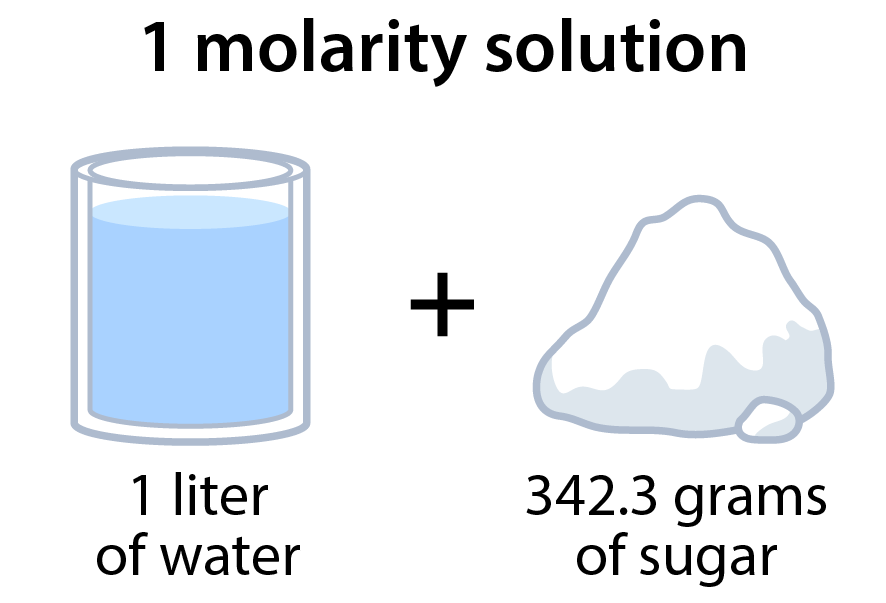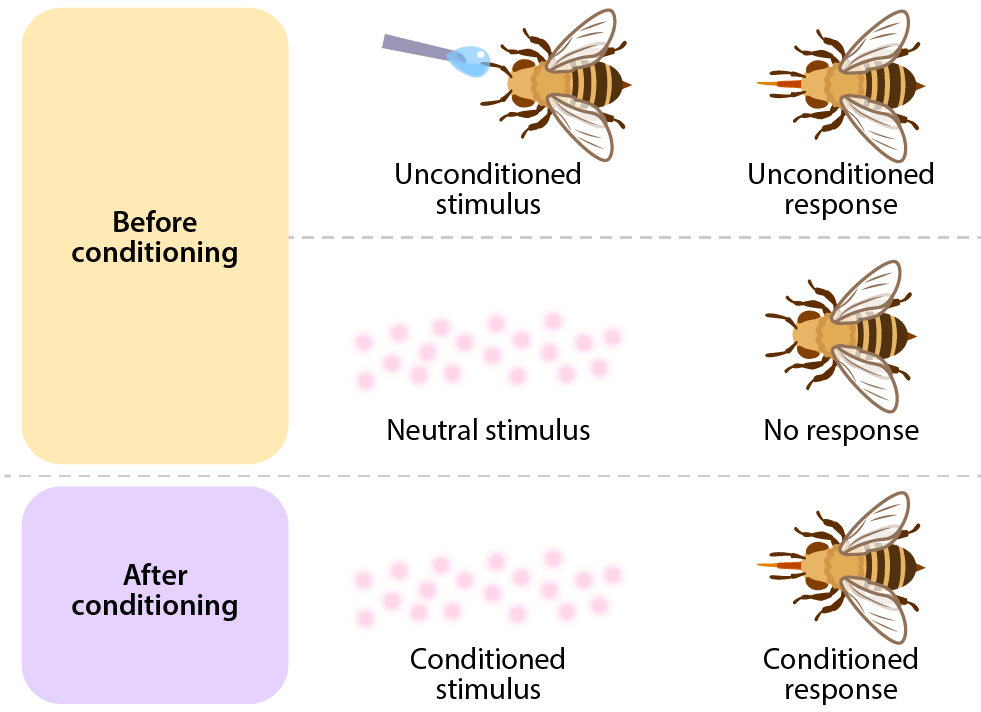About the science
Bee senses and behavior
It's early in the morning, and you decide to go to the bakery for a snack. As you enter the store, the first thing you notice is the smell of fresh-baked bread. At the counter window, you see many colors and styles of cupcakes and pastries. The cashier hands one to you and you notice the crispy texture of the baked dough with your fingers. You can feel that it's still warm from the oven. Your nose, eyes, and hands let you sense your food and the world around you.
But we aren't the only animals that do this… in fact, most animals do. The animals we are focusing on here, bees, mainly use their antennae and their eyes to collect information about the world around them. The outer surface of the antennae are covered in special cells that can sense odors, light, temperature, touch, and vibrations. Scent is especially important for bees, as bees use scent to find food and to communicate with other bees.
When a bee is interested in a scent, she will point her antenna and stick out her proboscis (or tongue) in the direction of that scent, looking for food. If a scent has been paired with a reward in the past, it's likely the bee will show more interest. By carefully observing the bee's movements, you can see how much she has learned to recognize the odor.
Reward strength
Bees eat pollen and nectar from flowers. Pollen contains many important nutrients, and nectar is a sweet sugary fluid which gives bees energy. In the lab, sugar water can be used as a reward for bees, as it's similar to nectar.
The reward strength means how much sugar the mixture has and it's measured in a unit called molarity. Scientists often use molarity to measure concentration. It describes the "actual concentration" of a substance (like sugar) mixed in certain liquids (like water). Bees prefer rewards with the highest possible amount of sugar.
What is molarity?
To measure actual concentration of a substance is a bit harder than you might think. Let's look at an example. Sugar (sucrose; C12H22O11) is a large, heavy molecule in comparison to salt (sodium chloride; NaCl). This means that if you weigh out 100 grams of sugar and 100 grams of salt, you'd have way more molecules of salt than of sugar. The “actual concentration” of molarity takes the number of molecules into account. So one mole of sugar has the same number of molecules as one mole of salt.
The molecular mass of sugar, or the weight of one mole of sugar is 342.3 grams. To make a 1 M (or 1 molar) solution, you would mix that mole of sugar into one liter of water. In this experiment, you don't have to worry about exactly how much sugar you are using. Just realize that 1.5 M sugar water (513.5 g sugar in a liter of water) is much more concentrated than 0.5 M sugar water (171.2 g sugar in a liter of water). Bees respond more strongly to more concentrated sugar water, so a higher molar reward will help them learn faster.

Brain activity and learning
When a bee encounters a scent, information from the antennae is sent to a part of the brain called the antennal lobe. The bee has two of these lobes, one for each antenna. The antennal lobes are made up of many different glomeruli, or bundles of nerves.
When a bee recognizes a familiar scent, a certain pattern of glomeruli will become active.* If this scent meant that food was near or a reward was given previously, then based on their learning of this scent, the bee may expect to find food or a reward when they smell the same scent. This is called the bee's expectation, and you can often tell if they expect something by whether they move their antennae forward or not.
In the experiment, after a trial, you can review the activity in one of the bee's antennal lobes. Watch what happens in the antennal lobe when the bee in your trial is presented with an odor. The colors of the glomeruli will indicate the amount of activity that is happening in different areas of the lobe. A different pattern will appear for each odor presented.
As the bee learns to associate a specific odor with a reward, you may see the pattern of glomeruli become more focused. However, you can also see the reverse of this happen. If an odor that a bee associated with a reward is then given several times without a reward, you may notice that they start to unlearn this association. This "unlearning" is called extinction.
There's another type of learning that is hard to notice, but that may also occur in some of your trials. When a bee is strapped in and then given an odor stimulus followed by a reward, they start to learn more than just the odor. They also start to learn that when they are strapped in, odors (no matter which odor) may be a sign that a reward is coming. This expectation that is based just on the methods (or procedure) of the experiment itself is called procedural learning. This effect is only seen in certain situations when you switch between stimuli.
Calculating learning
Mathematical models help us explain and predict what we see in our experiments. One of the most famous models for classical conditioning is the Rescorla–Wagner model. It was created in 1972 by two psychologists who specialized in learning, Robert Rescorla and Allan Wagner. This formula can be used to calculate the changes in the bee's expectations for a reward from one trial to the next.
Rescorla–Wagner model:
delta-VX = CSX * k * (lambda - Vt)
- delta-VX: The change in expectations for a reward from one trial to the next.
- CSX: Whether the stimulus (here, the odor) is present (1) or absent (0)
- k: How quickly the bee learns (from 0 - 1). This will be different for each bee, based on how well they can focus on this kind of task.
- lambda: The strength of the reward.
- Vt: The bee's total pre-trial expectation for any stimuli being used in the experiment.
When you run your experiment, the Rescorla-Wagner model is used to calculate the orange blossom and rose blossom-related expectations after each trial. You can see these values in the graph and table section in the experiment data.
When running an experiment with real bees, we can't see the exact value of the expectation calculated in the Rescorla-Wagner model by observing the bee's behavior. But, we can get a general idea of how strong that value is by observing whether the bee has a weak, intermediate, or strong response. A stronger response means the bee has a higher expectation for a reward when it sees a certain stimulus.
Once you've completed an experiment, look at the values in the graph. The dotted lines show the thresholds for weak, intermediate, and strong responses there. Make sure to notice how the response behaviors you observed relate to the expectation values.
Learn more about classical conditioning
Let's take a deeper look at classical conditioning. Below are a few important terms that are helpful when thinking about classical conditioning and describing your experiment.
- An unconditioned stimulus is something that naturally causes a reaction without any learning needed. Seeing and smelling food might cause a bee to show interest by sticking out her proboscis. So, food would be an unconditioned stimulus.
- An unconditioned response is the reaction that happens naturally in response to the unconditioned stimulus. A bee sticking out her proboscis is an unconditioned response to sugar water being touched to a bee's antennae.
- The reward is a positive outcome or item that the bee naturally wants. In this experiment, sugar water is the reward. A bee will prefer sugar water with a higher concentration of sugar.
- A neutral stimulus is something that the bee does not have a reaction to. Before conditioning, the orange blossom and rose blossom odors are neutral stimuli.
- The conditioned stimulus is something that didn't cause a reaction before conditioning, but does cause a reaction after conditioning. After conditioning, the orange blossom and rose blossom odors could be conditioned stimuli.
- A conditioned response is a reaction to the new stimuli the bee has learned. The bee sticking out her proboscis is a conditioned response to orange or rose blossom odors after you've taught her to recognize those odors.

*Locatelli, F., Fernandez, P., Smith, B. 2016. Learning about natural variation of odor mixtures enhances categorization in early olfactory processing. J Exp Biol 1 219 (17): 2752–2762.
*Marachlian, E., Klappenbach, M., and Locatelli, F. 2021. Learning-dependent plasticity in the antennal lobe improves discrimination recognition of odors in the honeybee. Cell and Tissue Research 383: 165-175.